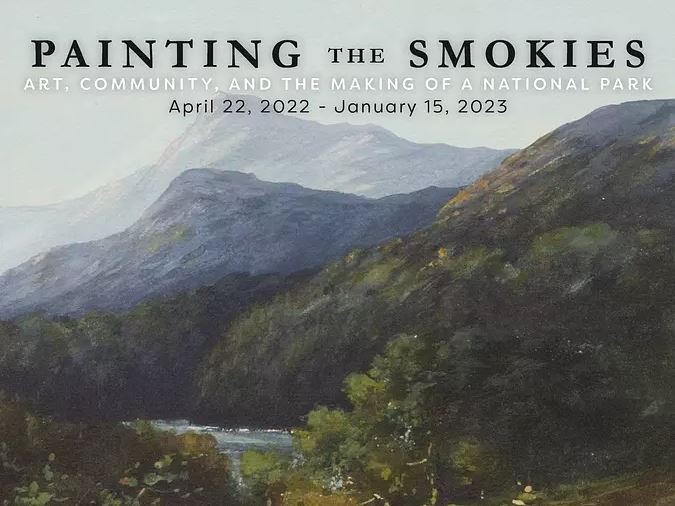Tennessee State Museum Explores the Creation of The Great Smoky Mountains Through its Landscape Paintings
‘Painting the Smokies: Art, Community, and the Making of a National Park’ runs from April 22, 2022 – January 15, 2023Download high resolution images here: https://tnmuseum.org/painting-the-smokies
NASHVILLE. Tenn. – March 30, 2022 – Home to the most-visited national park in America, the Great Smoky Mountains have enchanted tourists, nature-lovers and artists for generations. A new exhibition at the Tennessee State Museum in Nashville, Painting the Smokies: Art, Community, and the Making of a National Park, invites visitors to examine the
history of the park through the work of five visual artists active around the time of its creation, about 1900 to 1940. Placing art in conversation with artifacts, the two-gallery, 8,000 square foot show will open April 22, 2022, and run through January 15, 2023. The exhibition will be complemented by a variety of public programming and digital offerings to be announced soon.
“In any art exhibition, cultural context can provide a key to understanding both the artist and their art,” said Ashley Howell, executive director of the Tennessee State Museum. “Being a collecting institution of both art and artifacts provides a unique opportunity to not only showcase the art, but to pair the work with artifacts representative of the time. The visitor has the ability to reflect on not only the visual imagery of the era but also do so within the context of the area’s significance and history.”
Home to Cherokee, free and enslaved Black people, and white settlers by the 1700s, southern Appalachia became the topic of national fascination at the turn of the twentieth century. The grassroots campaign to create a national park in the Smokies occurred during a period of great change in the region, fueled by this renewed interest. Through the works of five artists who painted the Smokies during this time – all represented in the Museum’s collection – the exhibition explores how the Smokies inspired a generation of painters, and how art brought attention, activism, and tourism to the region. Sections of the exhibition include “All Eyes on the Smokies,” “A Most Excellent Opportunity,” “Art & Activism,” “Tradition in Tension,” and “Selling the Smokies.”
The artists represented include:
Charles C. Krutch – A self-taught East Tennessee native, Krutch was renowned for his depictions of the mountains, which he painted as familiar friends. His traditional landscape paintings emphasized the grandeur and mystery of the mountains at a time of growing national interest in the region. On the eve of the park’s opening, Krutch became one of the first artists commissioned by the Works Progress Administration at age 88.
Thomas C. Campbell – An English immigrant, Campbell relocated to East Tennessee for his wife’s health and quickly joined Knoxville’s thriving art community. Campbell brought the same academic approach to his depictions of the Smokies as his scenes of Paris and Rome. Led by the Nicholson Art League—where Campbell was a member alongside artists like Catherine Wiley and Lloyd Branson— Knoxville artists bolstered the city’s efforts to promote itself as a sophisticated leader in the New South.
Rudolph F. Ingerle – Trained at the Art Institute of Chicago, Ingerle found inspiration in the Smokies for his vibrant landscapes and portraits of mountain residents. He arrived in the mountains in the mid-1920s, as dramatic devastation from the logging industry fueled a push for preservation. Exhibited in major art centers, Ingerle’s art helped raise awareness of the region during the height of campaigning to conserve the landscape.
Will Henry Stevens – Stevens turned to the Smoky Mountains for his exploration of modern art techniques, creating a diverse range of landscapes from his Gatlinburg base. Stevens wrote that mountain residents’ connection to the land and their ancestral cultures inspired him. Mountain life and culture, however, were radically changing as residents were displaced by the park land acquisition and communities adjusted to the rise of tourism.
Louis E. Jones – By the time President Franklin D. Roosevelt dedicated the Park in 1940, artists like Louis E. Jones had found an important audience for their work among tourists to the area. Unsatisfied with painting the mountains of his native New England, Jones moved to Gatlinburg where he found the “charm of mystery” and “spiritual significance” he sought for his art. Establishing the famous Cliff Dwellers Studio, his paintings offered visitors a way to take home artistic representations of the region’s natural beauty.
Joining the five painters, the exhibition includes the diverse voices and stories of others who either called the region home or found inspiration and opportunity in the mountains. These include photographer George Masa, writer Horace Kephart, furniture craftsman Lewis Buckner, and visual artist Catherine Wiley. Also represented are Cora E. Burke, activist and chair of the Negro Women’s Department at the Appalachian Exposition, Cherokee basket maker Rowena Bradley, and iconic Little Greenbrier residents, The Walker Sisters, among others.
For more information about Painting the Smokies: Art, Community, and the Making of a National Park and its associated programming, please check TNMuseum.org.
About Tennessee State Museum
Celebrating its 85th Anniversary in 2022, the Tennessee State Museum, located on the corner of Rosa L Parks Blvd. and Jefferson Street at Bicentennial Capitol Mall State Park, is home to 13,000 years of Tennessee art and history. Through six permanent exhibitions titled Natural History, First Peoples, Forging a Nation, The Civil War and Reconstruction, Change and Challenge and Tennessee Transforms, the Museum takes visitors on a journey – through artifacts, films, interactive displays, events and educational and digital programing – from the state’s geological beginnings to the present day. Additional temporary exhibitions explore significant periods and individuals in history, along with art and cultural movements. The Museum is free and open to the public Tuesdays to Saturdays from 10 a.m. – 5 p.m. and Sundays from 1 p.m. – 5 p.m. For more information on exhibitions and events, please visit TNMuseum.org.
Download high resolution images here: https://tnmuseum.org/painting-the-smokies
# # #
